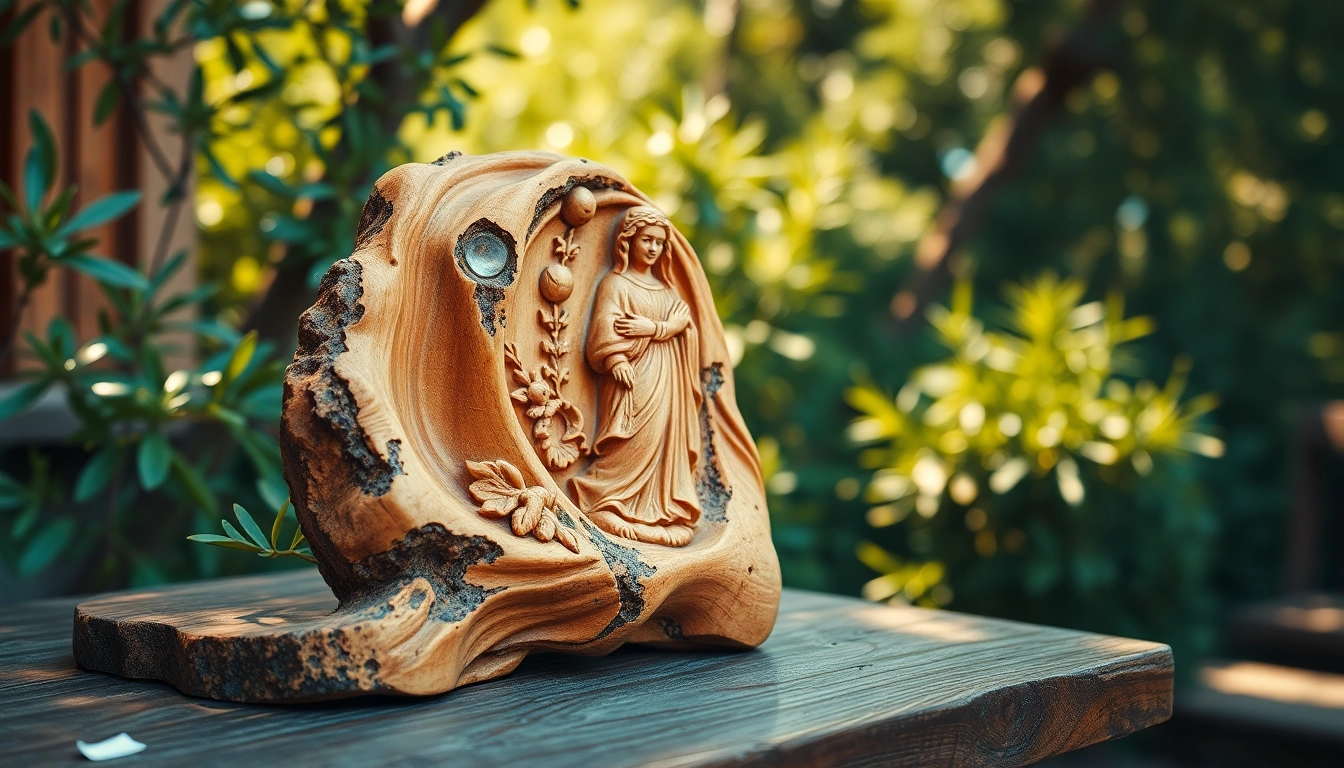Understanding Olive Wood Carvings
Olive wood carvings represent not just a form of artistic expression, but also a bridge between culture, history, and sustainability. Traditionally crafted by skilled artisans, particularly in regions like the Holy Land, these pieces carry deep significance for both Christians and art enthusiasts around the world. The allure of olive wood carvings extends beyond their aesthetic appeal; they embody stories of faith, craftsmanship, and the beauty of the Mediterranean landscape.
What are Olive Wood Carvings?
Olive wood carvings are intricately designed artworks made primarily from the wood of the olive tree, known for its durability and striking grain patterns. These carvings vary in form, ranging from simple functional items like bowls and utensils to complex religious icons and statues. Each piece is typically hand-carved, reflecting the skill and creativity of the artisan. The process involves shaping the wood, often using traditional hand tools, and finishing it with natural oils or wax to enhance the beauty of the wood grain and provide protection.
The Significance of Olive Wood in Art
The olive tree holds a sacred place in many cultures, especially in the Mediterranean regions where it is often associated with peace, prosperity, and healing. In Christianity, the olive branch signifies peace and hope, making olive wood carvings popular among religious communities. The wood itself is revered not just for its physical properties but also for its cultural and spiritual significance, often seen as a medium through which the stories of the Bible come to life. Consequently, olive wood carvings adorn churches and homes, serving both as decorative and spiritual artifacts.
Unique Characteristics of Olive Wood
Olive wood is distinguished by its rich color palette, which ranges from light yellow to deep brown, often accented with dark streaks and unique grain patterns. Its density and hardness not only make it a favorite among carvers but also contribute to its durability. Unlike many other types of wood, olive wood does not warp or crack easily, making it ideal for intricate carvings. Additionally, the wood’s natural oils give it a distinctive scent and a protective quality, ensuring that pieces can withstand the test of time.
The History of Olive Wood Carvings
Origins and Cultural Context
The art of olive wood carving can be traced back centuries, deeply rooted in the cultural practices of the Mediterranean and Middle Eastern regions. Ancient civilizations utilized olive wood for its strength and beauty in various functional and decorative applications, from utensils to religious artifacts. As Christianity spread across Europe, the tradition of olive wood carving flourished in areas surrounding the Holy Land, particularly Bethlehem and Jerusalem, where artisans began crafting intricate religious figures and scenes from the life of Christ.
Traditional Techniques and Tools
Artisans employ a variety of traditional techniques when working with olive wood, often passed down through generations. Tools commonly used include chisels, knives, and gouges, all designed for precision carving. The artisans begin with rough cuts to establish the basic shapes before moving on to finer details. This meticulous process can take hours, days, or even weeks, depending on the complexity of the piece. Artisans often work in small workshops, creating a communal atmosphere that fosters learning and collaboration among experienced and novice carvers alike.
Evolution of Styles over the Centuries
Styles and themes in olive wood carvings have evolved significantly over the centuries, influenced by changing artistic movements, religious contexts, and cultural interactions. Early pieces often depicted biblical scenes and figures, created with a focus on functionality and religious symbolism. As demand for decorative art grew, artisans began to explore more abstract and ornamental designs, incorporating elements from various artistic traditions. Today, olive wood carvings can be found in a range of styles, from classical to contemporary, each reflecting the unique vision of the artisan while honoring age-old techniques.
Buying and Caring for Olive Wood Carvings
Where to Find Authentic Olive Wood Carvings
For those seeking genuine olive wood carvings, authentic pieces are most commonly found in the Holy Land, particularly in local markets and artisan workshops. Various online platforms also provide access to high-quality carvings from reputable sources. When purchasing online, it is advisable to verify the authenticity of the seller, look for customer reviews, and ensure the craftsmanship reflects traditional methods. Supporting local artisans not only promotes fair trade but also helps preserve this ancient art form.
Tips for Purchasing High-Quality Pieces
When selecting olive wood carvings, consider the following tips to ensure you are making a quality purchase:
- Inspect the Craftsmanship: Look for smooth edges and intricate details in carving that reflect the skill of the artisan.
- Check for Authenticity: Ensure the piece is made from genuine olive wood, preferably sourced from the Holy Land.
- Assess the Finish: High-quality pieces are typically treated with natural oils that enhance the wood’s beauty and durability.
- Consider the Purpose: Choose pieces that align with your intended use, whether decorative, functional, or religious.
Maintenance and Care Instructions
To preserve the beauty and integrity of olive wood carvings, proper care is essential. Here are some maintenance tips:
- Cleaning: Use a soft, damp cloth to wipe down your carvings. Avoid submerging them in water, as excessive moisture can damage the wood.
- Re-oiling: Periodically apply a light coat of food-safe mineral oil or olive oil to maintain the wood’s luster and prevent drying.
- Avoid Direct Sunlight: Keep carvings away from direct sunlight to prevent fading and degradation of the wood.
- Temperature Control: Store carvings in a stable environment that avoids extreme heat and humidity, which can warp the wood.
The Role of Olive Wood Carvings in Home Decor
Integrating Olive Wood Carvings into Your Space
Olive wood carvings can add warmth and a touch of nature to any home decor. Their unique designs make them versatile, complementing various interior styles, from rustic to modern. Here are some ideas for incorporating olive wood pieces into your decor:
- Statement Pieces: Use larger sculptures as focal points in living rooms or entryways to spark conversation.
- Functional Art: Consider using olive wood bowls or platters as both decor and serving ware, merging beauty with functionality.
- Gallery Walls: Create a gallery wall featuring small carvings and wall art, layering various textures and colors.
Olive Wood as Meaningful Gifts
Olive wood carvings make thoughtful and meaningful gifts for various occasions such as weddings, graduations, or religious ceremonies. They carry a story that resonates with cultural and spiritual significance, making them cherished keepsakes. Personalized pieces, such as engraved names or dates on carvings, can enhance their value as gifts, adding a unique touch that resonates with the recipient.
Decorating with Olive Wood: Creative Ideas
Here are some creative ways to decorate with olive wood carvings:
- Table Centerpieces: Use carved bowls filled with seasonal fruit or flowers as eye-catching centerpieces.
- Shelf Styling: Mix olive wood carvings with books, plants, and other decorative items on shelves to create a balanced look.
- Seasonal Displays: Change your displays seasonally by incorporating olive wood carvings with seasonal decor items, enriching their visual appeal.
The Future of Olive Wood Carving
Sustainability and Ethical Considerations
As the global demand for olive wood carvings continues to rise, sustainability and ethics in sourcing are becoming paramount. With the threat of deforestation and climate change, ensuring that olive wood is sourced responsibly is crucial. Artisans and suppliers can adopt practices that promote sustainable harvesting, working closely with local farmers and communities to oversee growth and replanting of olive trees. Buyers can contribute by selecting products from reputable sources that prioritize sustainability.
Contemporary Artists and Innovations
Today, modern artists are reinvigorating the art of olive wood carving by experimenting with new designs and techniques. Contemporary pieces may blend traditional craftsmanship with modern aesthetics, often creating unique artworks that push the boundaries of conventional carving styles. Collaborations between artisans and designers are increasingly common, resulting in innovative expressions of olive wood art that attract a new generation of collectors.
Trends in Olive Wood Carving Today
Several trends are shaping the future of olive wood carving:
- Minimalist Designs: A rising trend toward minimalism sees artists creating clean, simple lines that highlight the natural beauty of the wood.
- Functional Art: More pieces are being designed with functionality in mind, blurring the lines between art and everyday items.
- Personalization: Increasing demand for personalized pieces reflects a desire for unique, one-of-a-kind gifts and home decor items.
The future of olive wood carvings appears vibrant as artisans continue to innovate while cherishing their rich cultural heritage. By embracing sustainability and design evolution, this traditional art form remains relevant, ensuring that the beauty of olive wood will be celebrated for generations to come.























+ There are no comments
Add yours